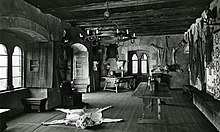Gnandstein Castle
| Gnandstein Castle | ||
|---|---|---|
|
Gnandstein Castle |
||
| Creation time : | Early 13th century | |
| Castle type : | Hilltop castle | |
| Conservation status: | Received or received substantial parts | |
| Place: | Gnandstein | |
| Geographical location | 51 ° 1 '6 " N , 12 ° 34' 33" E | |
|
|
||
The Gnandstein is in Gnandstein , a district of Frohburg , in the district of Leipzig in Saxony . The castle is considered to be Saxony's best-preserved Romanesque fortification. The place is located in the Kohrener Land tourism region .
location
The hilltop castle stands on a porphyrite rock above the valley of the Wyhra river in the central Saxon hill country .
history
The castle was built as a Romanesque complex at the beginning of the 13th century, probably first with a rectangular floor plan and residential tower . A 25 m deep castle fountain in the castle also dates from this time . A fountain house was later built to protect the fountain, but was built over by the expansion of the south wing in the Gothic style.
Around 1225/30 a three-storey palace was built , which was increased by one storey in the late 14th century. On the second floor there is a hall with triplet windows with Romanesque capitals. Only a little later, the ring wall in the east was built in front of a fence wall as an essential extension of the defensive systems . The outer walls were extended several times. In the middle of the 13th century, a round keep was built in the upper courtyard of the castle .
The castle complex had been the seat of the von Schladebach family, later called Marschall von Bieberstein , since 1228 . After this family lost their inheritance in the 14th century, Gnandstein Castle with 40 villages and parts of the village was taken over by the von Einsiedel family in the late 14th century , which has been documented in Saxony since the 15th century and was also wealthy in the Ore Mountains. The Einsiedel had the lower castle expanded to make it more comfortable. In the 15th century the gatehouse and the three- story Gothic residential wing were built in the south, which still defines the image of the castle today. The loopholes in the basement of the south wing show that this part of the castle could also be defended. Under the eaves there was a late Gothic plaster frieze, which was reconstructed at one point. Heinrich von Einsiedel had the castle chapel built into the opposite north wing, which was inserted between two older castle walls . The angled room with cell vaults contains three carved winged altars from the workshop of Peter Breuer and a choir stalls made of oak. Despite the Einsiedel's early commitment to the Reformation - Heinrich Hildebrand von Einsiedel (1497–1557) corresponded with Martin Luther and other reformers - the castle chapel, which is now used for Protestant services, was no longer modified, which is why it is superbly preserved in its late Gothic original state.
The formerly three late Gothic fortified cellars (early form of the casemates ) with sinkholes that were created for the use of firearms are remarkable . A fortified cellar with a fountain has been restored and is part of the museum tour.
During the Thirty Years War the castle was ravaged by Swedish troops and partially destroyed. Shortly before the end of the war, the south wing burned down after a lightning strike. The damage was repaired and the interior was completely redesigned at the beginning of the 18th century. The inner courtyard was given a stone arcade. Further modifications followed in the 19th century. Woldemar Kandler was one of the builders involved in the architectural redesign.
The last private owners of the castle were Hanns von Einsiedel (1878–1958) and his daughter Sibylla Freifrau von Friesen (1905–1984) before they were expropriated in 1945. Before that, Herr von Einsiedel had the castle renovated and redesigned again at the beginning of the 20th century. He founded the museum in the castle and opened the chapel for viewing.
From the Second World War to 1990, little safety work was carried out. At the beginning of the 1990s, archaeological excavations began in the tower and kennel courtyard. Since 1992 the castle has been under the administration of the State Palaces, Castles and Gardens of Saxony . In the years 1994-2004 the castle was restored and structurally secured. The exhibition was enriched in 2004 by the Groß Collection, which was donated to Gnandstein. It includes 338 objects from Meissen porcelain to furniture and sacred plastic to Dutch paintings from the 17th century.
literature
- Reinhold Grünberg: Chronicle of Gnandstein. Gnandstein 1901 ( digitized version )
- Otto Eduard Schmidt : Gnandstein Castle, the reflection of a millennium of German culture. In: Communications of the Landesverein Sächsischer Heimatschutz Volume XV, Issue 11–12 / 1926, Dresden 1926, pp. 361–385
- Helmuth Gröger: The Gnandstein Festival . In: Burgen und Schlösser in Sachsen , Heimatwerk Sachsen, 1940, pp. 76–77
- Otto Eduard Schmidt: Since when did the Lords of Einsiedel sit at the Gnandstein and Wolkenburg castles . In: Mitteilungen des Landesverein Sächsischer Heimatschutz, Vol. XVI, 1927, p. 316
Web links
Individual evidence
- ^ Matthias Donath: Castles and palaces in Saxony. M. Imhof Verlag, Petersberg 2012, ISBN 978-3-86568-768-5



